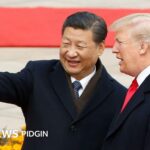A recent spike in trade tensions between the United States and China has ignited volatility in the financial markets, causing stocks to drop significantly. The Dow Jones Industrial Average fell nearly 900 points on Friday following President Trump’s threats of imposing higher tariffs on Chinese goods, a development that investors had largely overlooked since April. This shift also saw the S&P 500 decline by over 2%, while the Nasdaq Composite experienced a slide of more than 3%.
As investors brace for upcoming earnings reports, they are left questioning whether the recent sell-off is an isolated event or indicative of deeper issues as the earnings season approaches. Jay Woods, chief market strategist at Freedom Capital Markets, remarked that the uncertainty surrounding tariff threats, compounded by an ongoing government shutdown, adds to the market’s unease. He noted, however, that this may just be a negotiating tactic that could lead to positive outcomes in the long run, advising investors to look for potential buying opportunities amidst the dip.
In the backdrop of these tensions, the financial sector is expected to play a crucial role in driving market momentum. Major banks including Citigroup, Goldman Sachs, and JPMorgan Chase are slated to release their earnings on Tuesday and Wednesday, with many analysts anticipating solid performances bolstered by recent activity in capital markets and an uptick in deal-making. FactSet data suggests that the financial sector could experience a blended earnings growth rate of 12.9%, a significant contributor to the overall growth expected for the S&P 500 at 8.1%.
Investors are also facing the reality of a federal government shutdown that extends into its second week, with a critical date approaching on October 15, coinciding with the next pay period for many federal workers. The likelihood of the shutdown concluding before this deadline stands at a mere 6%, according to Polymarket. The prolonged shutdown not only affects government employees but also delays the release of important economic data, such as the Consumer Price Index (CPI), raising concerns among market participants. The IRS has already initiated furloughs, and a significant portion of its workforce is currently inactive, which could hinder the timely release of crucial economic indicators.
Despite initial resilience, Wall Street analysts warn that the ongoing shutdown and trade tensions could compound existing market risks, particularly related to inflation and interest rates. Recent data from Bank of America noted that U.S. job growth weakened, although wage growth remained stable, reflecting consumer resilience. Morgan Stanley has expressed concerns over the deteriorating quality of government data which impacts economic assessments.
Meanwhile, the gold market has experienced a significant surge, crossing the $4,000 mark for the first time, which has puzzled many investors. Traditionally seen as a safe haven, gold’s rise amid soaring stock prices raises questions about market sentiment and the potential for a shift in asset preferences. There are indications that some investors may be gravitating toward gold as trust in the U.S. dollar wanes.
Concerns about a possible market bubble are also front and center, with comparisons being drawn to the dot-com era of the late 1990s. Investors appear to be chasing returns reminiscent of past frenzies, particularly in technology sectors driven by advancements in artificial intelligence and digital infrastructure.
Looking ahead, the calendar for the upcoming week indicates a busy earnings schedule, while critical economic data is anticipated to be delayed due to the ongoing government shutdown. As investors prepare for the financial landscape’s next moves, the combination of earnings reports and external economic pressures will significantly shape sentiment on Wall Street.







